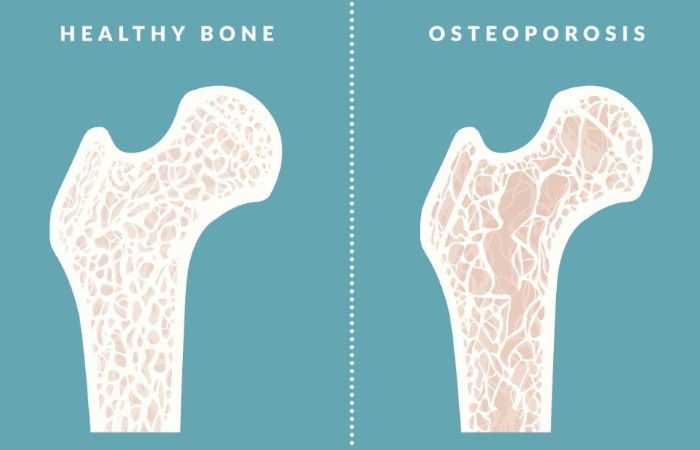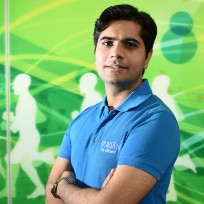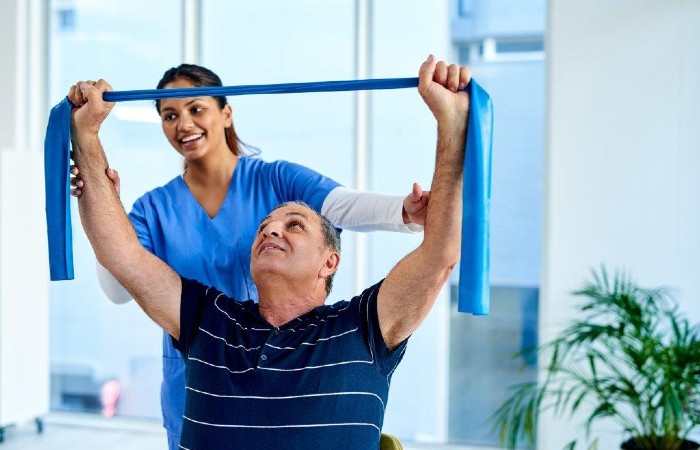

 By - Prashant Verma Functional Manual Therapist at VARDĀN |
|
Osteoporosis is a condition characterized by low bone mass or loss of some bone material
which makes them less dense and thin. In osteoporosis, bones can break more easily than
normal, especially if there is accident or fall. If there is milder degree of bone loss, then it is
known as osteopenia. It mainly affects older people but it can affect someone at any age. Women lose bone material more rapidly than men, especially after the menopause when their levels of oestrogen fall. Oestrogen is a hormone and helps to protect against bone loss. At the age of 50, about 2 in 100 women have osteoporosis. This rises to 1 in 4 women at the age of 80. However, osteoporosis can also affect men. |
|
Thinning of the bones usually develops slowly over several years, without any symptoms. However, after a certain amount of bone loss, the following may occur.
|
|
| The following may help to prevent, or slow down, bone loss. This advice is for everyone. However, it is particularly important if you are at increased risk of developing 'thinning' of the bones (Osteoporosis). |
| Exercise can help to prevent osteoporosis. The pulling and tugging on the bones by your muscles during exercise help to stimulate bone-making cells and strengthen your bones. Regular weight-bearing exercise like walking, jogging, Standing Exercises etc) at least 30 mins in a day 5 times per week is advisable by WHO. Muscle strengthening exercises are also important. They help to give strength to the supporting muscles around bones. This helps to increase tone, improve balance, etc, which may help to prevent you from falling. |
| Calcium and vitamin D are important for bone health. Your body needs adequate supplies of vitamin D in order to take up (absorb) the calcium that you eat or drink in your diet. The recommended daily intake for calcium in adults over the age of 50 is at least 1000 mg per day. |

|
Functional Manual Therapy® (FMTTM) is a comprehensive approach to physical therapy,
which optimizes the musculoskeletal and neuromuscular systems to eliminate pain and
bring patient’s life to an optimum functioning level. Goals of our treatment include:
Our specially trained Functional Manual therapist by using our expertise in anatomy and biomechanics help mobilize joints and muscles so that our bodies function more efficiently. |

| Our Client Speak I am pleased to be introduced to Vardan way of Physiotherapy. My name is Sushma Chandra, and my first treatment began with Therapist Casey in 2016, and since then I have taken regular sessions for multiple issues from scar tissue release to hip and knee alignment and also rib releases. Currently Tanu has been My regular therapist with successfully treating my trigeminal headaches as well as scar tissue management. Mr. Chandramohan recommended Prashant for my sisterinlaw who had been having orthopedic issues related to knee pain, gait misalignment and hip issues. All doctors recommended surgery, but with Prashant's diagnostic assessment and Pratibha Kumari's positive attitude, in just five sessions he was able yo get her pain 70% relieved by Functional manual techniques(FMT) and was able to motivate her to use exercise, alignment awareness and icing to manage pain. She was able to go out and walk and be on her feet for five hours after fourth session and climb stairs and bend her knee and feel motivated to continue treatment. Being outstation patient she had to return but she has come home confident, motivated and to be able walk using both legs again was a wonderful gift Vardan Team gave to Ms Pratibha. Special thanks to intuitive guidance of Mr. Chandramohan and remarkable treatment and motivation provided by Therapist Prashant. - Sushma Chandra |


|
VARDĀN is open for consultation & treatment sessions. You can book an appointment with our Functional Manual Therapist to avail our services. We are following stringent precautionary measures for your safety. To contact, you may call or mail us. |
Please call 011-43580720-22, 8:30 AM to 6:00 PM
Monday to Sunday
You may also contact our team on
+91-9971112446, +91-9910955500, +91-9810306730, +91-9910855500
Email: vardan@timesgroup.com | Web: www.vardan.in
Address: 16-A, Ring Road, Lajpat Nagar- IV, New Delhi 110024
